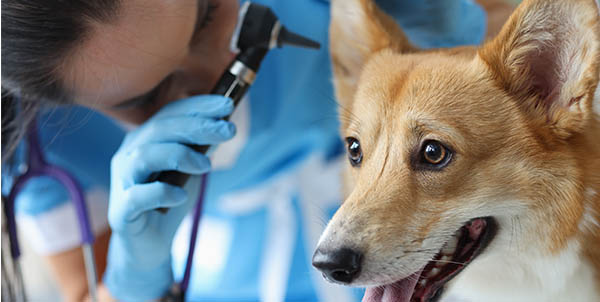Table of Contents
What is vestibular syndrome in the dog?
Vestibular syndrome is a neurological disorder that can affect dogs of all ages but is particularly prevalent in older dogs.
It affects thevestibular apparatus, which is responsible for regulating the dog’s balance and orientation, and is therefore manifested by lack of coordination and staggering, abnormal head tilt (commonly referred to as “head tilt“) oscillatory movements of the eyes in horizontal, vertical or circular directions(vestibular nystagmus).

So labyrinthitis in dogs, characterized by dizziness and loss of balance, is often a disorder associated precisely with vestibular syndrome.
Also: difficulty eating and drinking, nausea and loss of appetite, difficulty urinating and defecating.
In most cases, the symptoms of this condition develop suddenly and are quite frightening to human parents of four-legged animals with compromised vestibular apparatus.
What does the dog’s vestibular apparatus look like?
The vestibular apparatus as in humans so also in dogs and cats, is made up of a central portion (brainstem and cerebellum) and a peripheral portion(inner ear and peripheral portion of the cochlear vestibular nerve).
Its function is to get the dog moving, helping with orientation with respect to space and gravity and maintaining a correct position without loss of balance and dizziness.
How many types of vestibular syndrome are there?
Vestibular syndrome differs according to the anatomical site affected.
When it develops intracranially, it is called central.
Instead, it is called peripheral when it is located in the inner ear.
There is also a third form, called geriatric vestibular syndrome, which affects older dogs cases.
The most common causes of vestibular syndrome in dogs
Among the most common causes are infectious inflammatory diseases such as otitis involving the inner ear.
Plus trauma, ischemia, endocrine and metabolic disorders, and neoplasms.
The causes of geriatric vestibular syndrome, on the other hand, are less well known, probably attributable to inflammation of the vestibular portion of the 8th cranial nerve.
Diagnosis of vestibular syndrome in dogs: how to recognize it?
Otoscopic examination is the first step in confirming or excluding a diagnosis of otitis media-internalis.
If otitis media-internal extension to the central nervous system is suspected, examination of the cerebrospinal fluid is indicated.
Finally, tomographic examination and MRI are the two procedures of choice that allow simultaneous evaluation of the peripheral and central structures of the vestibular apparatus.
How to treat vestibular syndrome in young dogs?
Treatment varies according to the diagnosis made.
In case of ear infections, treatment consists of administering antibiotics (in the presence of bacteria) or antifungals (for fungal infections).
Peripheral forms generally have a better prognosis than central forms.
How, on the other hand, do you manage vestibular syndrome in elderly dogs?
Geriatric vestibular syndrome, in the absence of serious underlying causes and thus in the case of an idiopathic form, usually heals spontaneously, often even without any therapy, although it may continue to present some typical symptoms in a more or less mild form.
The dog’s recovery depends greatly on the cause of the problem, the severity of the symptoms, and the timeliness with which the dog is treated.
If you suspect that your dog suffers from vestibular syndrome, contact us immediately for a consultation: at our facility you can have your dog undergo a complete check-up and the necessary clinical examinations, using the advice of specialized Veterinary Doctors.
And again, in case of need and urgency Clinica La Veterinaria is always open h24 every day including holidays and with First Aid service from 8 pm to 8 am.
For the joy of seeing them HAPPY











